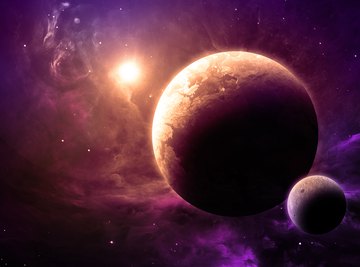
The answer to whether Mars or Venus is closer to the Earth is, "It depends." Mars and Venus are Earth's immediate neighbors in the Solar System. However, all three planets have nearly-circular orbits around the Sun and move at different speeds. So, sometimes Earth and Mars are close and Venus is on the other side of the Sun, and sometimes Venus is cozy with the Earth and Mars is the distant one.
TL;DR (Too Long; Didn't Read)
Venus gets closer to the Earth than Mars or any other planet: 38.2 million kilometers (23.7 million miles).
Distances Between Planets
At their closest, Mars is 55.7 million kilometers (34.6 million miles) from Earth but only 38.2 million kilometers (23.7 million miles) separates Venus and our planet. In relation to the sun, Venus is 108,200,000 kilometers (67,232,400 miles) away, Earth is 149,600,000 kilometers (92,957,100 miles), and Mars is 227,940,000 kilometers (141,635,000 miles) from the sun. For a more easily digestible size comparison, if you put the sun at one corner of the room, Venus would be two paces away, Earth just one half pace more, and Mars one and one half paces beyond that -- Pluto would probably take you outside your house, as it is 100 paces from the sun.
Facts About Venus
Venus spins in the opposite direction of Earth and has an atmosphere that destroys the NASA space probes in just a few minutes. The atmosphere is largely made of carbon dioxide and nitrogen. In terms of overall size, Earth and Venus are alike, but beyond that Venus is like an Earth where global warming has completely taken over. As the hottest planet in the solar system, the surface of Venus is 462 degrees Celsius (864 degrees Fahrenheit), and the planet is covered in volcanoes.
Facts About Mars
While Venus is a world on fire, Mars is cold -- temperatures range from -87 to -5 degrees Celsius (-125 to 23 degrees Fahrenheit). At approximately half the size of Earth, Mars has a desert surface but a very thin atmosphere. This tiny atmosphere is made up of carbon dioxide and nitrogen, like Venus, with argon added in. Mars may have had liquid water 3.5 billion years ago -- so much water, in fact, that there is evidence of giant floods on its surface.
The Terrestrial Planet "Club"
Mars, Venus and Earth are all similar, as they are three of the four terrestrial planets -- Mercury is the fourth. Terrestrial planets are “Earth-like” as they all have a core, a mantle and a crust. Plate tectonics, erosion and volcanoes change the surfaces of Mars, Venus and Earth. Earth’s moon is sometimes studied with the terrestrial planets because its makeup is similar to Earth, but it is not a planet.
References
About the Author
Kelly MacGregor holds bachelor's degrees in news-editorial journalism and ecology/evolutionary biology from the University of Colorado at Boulder. In addition to writing for the "Colorado Engineer Magazine," the "Boulder Daily Camera" and EdNews Parent, MacGregor's work has been picked up by the "Colorado Daily," EdNews Colorado and the "Denver Post."
